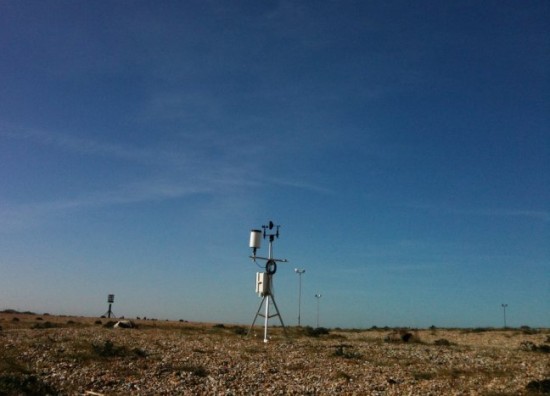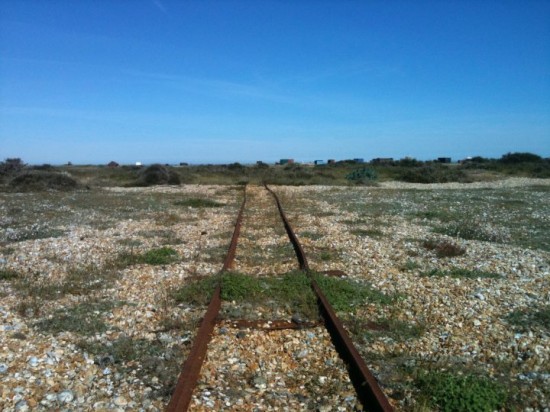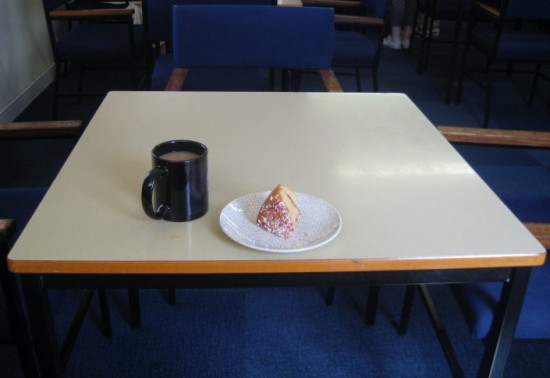
by Luke Turner.
The phrase “hottest day of the year thus far” is customarily taken by the British as an instruction to clog the roads in a mass exodus towards collective flesh singeing at our popular seaside resorts. But today a coach is heading in the wrong direction, to the sparsely-populated otherworld that is the promontory of Dungeness. Here, a shingle landscape shows through the scrub as if it is a rough canvas underneath the oils that make up the traditional portrait of Kent: woodland, small hedge-line fields, low-roofed farms and their attendant oast houses. This, by contrast, is an unforgiving place that defies romanticising; part primitive, part man-made.
Our coach pulls up in a car park outside the Britannia pub. A line of surf can be seen through the heat haze, and there, 120 metres from the bland grey shed of the Dungeness lifeboat station, stands a simple weather station. An anemometer spins in the brisk wind coming in from off the Channel; the passengers pull jumpers over their summerwear, as the vane snaps within just a few degrees of the compass. This is Variable 4, a PRS-funded sound installation that takes the digital stimuli from these receptors, and uses them to trigger pre-allocated fragments of music: “Every aspect of the piece, from broad harmonic progressions down to individual notes and timbres, is influenced by changes in the environment: wind speed, rainfall, solar radiation, humidity, tropospheric variance, temperature, and more.” reads the blurb, accompanied by some mind-boggling diagrams about it all works. It’s more rewarding, though, to ignore the science.
The music reaches us via speakers that are arranged in a circle, and hidden under pieces of flotsam and jetsam, driftwood, rusted steel cable, fragments of net. They emit long drones and the occasional thud. A piano refrain begins, for some reason drawing the eye to a small blue hulled boat, tilted forlornly to one side far above the high water mark. Clusters of people stand around listening, while one group settles down to a day-long picnic of rum. Something happens in the atmosphere, and the speakers become an orchestra limbering up for a Steve Reich recital. The hot sun beats down.
The success of Variable 4 owes much to the landscape that surrounds it. Romney Marsh was first reclaimed by the Romans – the cliffs of the original coastline can be seen through the haze, behind wind turbines, far inland. It’s a landscape that humans have part created, and then forgotten – which is why it suits the things that we’d rather hide on the fringes: the nuclear power station, the mysterious sound mirrors used to listen for approaching aircraft in the1920s that became obsolescent even before the Second World War was declared.

The synergy between installation and surroundings prompts you – in fact we’re encouraged – to look outside the circle of speakers, this sound-tracked foreshore, and explore. Variable 4 is organised in cooperation with the lifeboat station, who have arranged refreshments and a book sale – three editions of Lorna Doone, and RNLI calendars going for a donation now that it’s five months into the year. Homemade cake and good tea are served as lifeboat volunteers’ conversation about Twitter and oncologists ebbs against the coastguard radio in the corner.

Refreshed and walking west, two children bounce on a trampoline next door to Derek Jarman’s beautifully preserved garden. Behind it, the miniaturised (as much as miniature) trains of the Romney Hythe & Dymchurch Railway that pass in front of the power station make its bulk even more foreboding. There are unexpected bluebells amidst the dry grass next to a wooden house called Jesmond. The old black lighthouse, now redundant and replaced by a skinny device closer to the shore, is pockmarked with the white splatter of seagull guano, like a wartime building peppered with shrapnel.
From the top of the lighthouse, the surrounding area looks like an angry child has scattered its toys across a dirty grey sheet: box houses, the loop of railway, tiny cars and boats. Walking back past the sign for the Fifth Corner Mystical Gift Shop (staff away), two walkers enthuse about the hour-long piece they’ve just enjoyed back at Variable 4. It was reminiscent of the soundtrack to Moon… or was it the soundtrack to the moon? Back at the installation, the rum picnic has nearly run dry, and the speakers hum with a complaining, but not unpleasant sound, like one of those children’s toys you invert to play a groan. Underneath it, there’s a ponderous drum, giving the air of ritual. And this will continue all night, changing with the ebb of the tide, the plummeting temperature, a morning mist before this 24 hour conversation with the elements come to an end at about the time of Sunday lunch. But most of all, in the last fifteen minutes lying on the floor staring into the blue sky, what’s so striking is that these sounds created by nature become just part of its own music: the wind, a distant wash of surf, the arbitrary crunch of shingle, and skylarks that will sing their songs of flight as long as the warmth rises from these uncountable stones, when we are long gone.